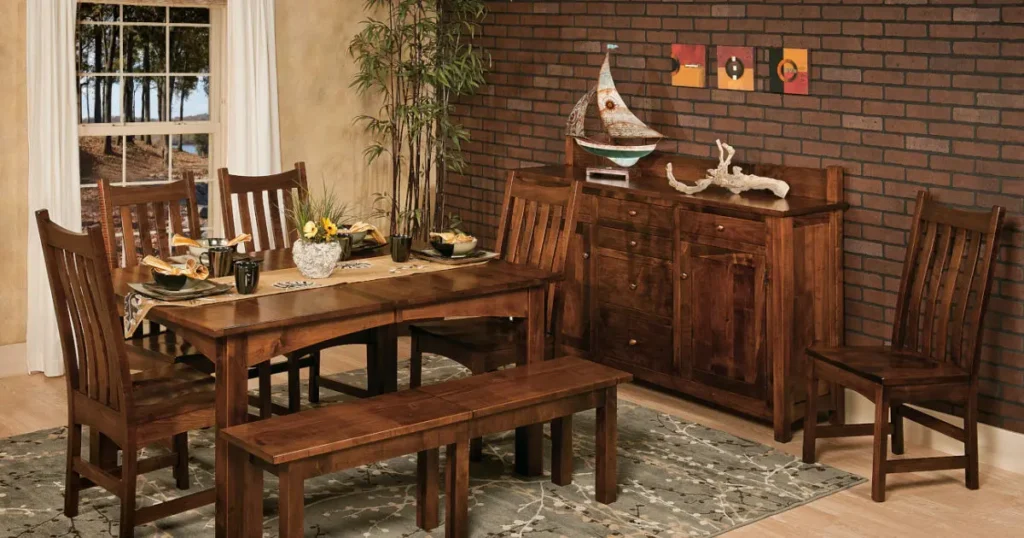In a world increasingly focused on sustainability and eco-consciousness, the art of Amish furniture-making stands as a shining example of responsible craftsmanship.
These skilled artisans, deeply rooted in tradition, have mastered the art of creating furniture that not only exudes timeless beauty but also embraces environmentally friendly practices.
From the thoughtful selection of wood to the utilization of renewable resources and the emphasis on handcrafted quality, Amish furniture-making is a model of sustainable, responsible craftsmanship.
Sustainable Wood Selection
The foundation of Amish furniture lies in the meticulous selection of wood, a process guided by principles of sustainability and respect for nature. Amish craftsmen prioritize locally sourced hardwoods, such as oak, cherry, maple, and walnut, reducing the carbon footprint associated with long-distance transportation.
Moreover, they often source their wood from sustainably managed forests, where the rate of harvesting is balanced by the rate of new growth, ensuring a continuous, renewable supply.
This approach not only minimizes the environmental impact but also supports local economies and promotes a closer connection to the source of their materials.
Minimizing Waste and Maximizing Efficiency
Amish woodworking practices are rooted in the principle of minimizing waste and maximizing resource utilization. Every aspect of the process is carefully considered, from the initial design to the final assembly. Offcuts and sawdust are often repurposed or used for other functions, such as heating homes, demonstrating a comprehensive approach to resource utilization.
Furthermore, the use of traditional joinery techniques, such as mortise-and-tenon and dovetail joints, eliminates the need for nails or screws, reducing the reliance on mined raw materials and the associated environmental impact.
This commitment to efficiency extends to the use of hand tools and pneumatic-powered tools, minimizing the consumption of electricity and fossil fuels.
Handcrafted Quality and Longevity
One of the defining characteristics of Amish furniture is its exceptional quality, a result of the skilled craftsmanship and attention to detail that goes into every piece. Amish artisans invest significant time and effort, ensuring that every joint is tight, every surface is smooth, and every detail is perfected.
This commitment to quality translates into furniture that is built to last for generations, reducing the need for frequent replacements and minimizing the demand for new resources.
The superior craftsmanship and use of high-quality materials ensure that Amish furniture can withstand the test of time, making it a sustainable choice in the long term.

Customization and Personal Touch
The handcrafted nature of Amish furniture allows for a high degree of customization, enabling customers to create pieces that truly reflect their personal style and preferences. From the choice of wood species and stain colors to the selection of hardware and upholstery, each piece can be tailored to meet individual needs and desires.
This level of customization not only adds a personal touch but also contributes to the longevity of the furniture, as pieces are designed to meet specific functional and aesthetic requirements.
By investing in custom made Amish furniture, homeowners can create timeless pieces that seamlessly integrate into their living spaces while embracing sustainable practices.
Eco-Friendly Finishes and Materials
In addition to their sustainable woodworking practices, Amish craftsmen prioritize the use of eco-friendly finishes and materials. Natural oils and stains are often used instead of synthetic varnishes and paints, which can release harmful volatile organic compounds (VOCs) into the environment.
This commitment to using non-toxic materials not only protects the environment but also ensures a safer and healthier indoor air quality for homeowners. Furthermore, the use of natural materials, such as leather and Crypton fabrics for upholstery, further enhances the eco-friendly nature of Amish furniture.
Conclusion
In a world where sustainability and environmental consciousness are becoming increasingly important, Amish furniture stands as a shining example of responsible craftsmanship.
From the thoughtful selection of wood to the minimization of waste and the emphasis on handcrafted quality, every aspect of the Amish furniture-making process is imbued with a deep respect for nature and a commitment to preserving resources for future generations.
By investing in Amish furniture, homeowners not only acquire timeless pieces of exceptional beauty but also contribute to a more sustainable future. Each piece is a testament to the artistry and dedication of skilled craftsmen, a harmonious blend of tradition and eco-consciousness.
Embrace the beauty of Amish furniture and make a conscious choice to support sustainable practices that will endure for generations to come.





